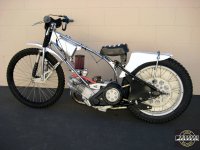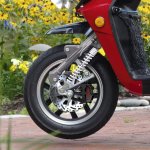fatty said:
marka-ee said:
Telescopic forks have the inherent problem of stiction
Have you actually quantified force required to overcome stiction in a coil-sprung fork?
Because this...
marka-ee said:
Support the bike by the seat. Put a 1 kg weight on the bars. Did the front suspension move ? No ? keep adding weight until the suspension moves even a micron.
...is not how.
Stiction just isn't going to be measurable, let alone significant, once you integrate spring and damper force. If you're worried about it, get a coil-sprung fork or low-friction SKF seals next rebuild.
Building around stiction will compromise on parameters that actually do matter, like spring rate.
My example of the weight on bars is meant to exemplify the stiction in a simple way.
Raw coil springs have zero stiction. Agree ? If I apply 10 gram of force on a 200# spring, the deflection is measurable. It may only be 0.0001 in, but it's there.
Dampers do have some, but not much if it's the size of a steering damper. But the large seals on the main sliding elements are much more especially with simple non roller bearings with the side loads that can be 60 lbs or more on braking.
Here is how I would quantify stiction on bike forks:
The Jig would attached to the crown or headset area, as in a bike mounting.
The axle would have a force, say 50 lbs applied at 90 degrees from the fork telescope direction. ( side load during braking simulation ).
A high resolution linear encoder would be clamped to the traveling section of the suspension. ( Encoders measure distance and can be interfaced with a computer to record the movements seen )
Now the crown part of Jig, which is fitted with a strain gauge also logged by computer, is forced down by an increasing controlled force.
The result of down force vs displacement is plotted X vs Y.
The graph will clearly show stiction when the force keeps increasing but the distance does not change.
For preload cancellation from results the down force can be stopped and restarted and the stiction again observed, when the distance again does not change when the force does.
The measurement can be repeated with various side loads and plotted on same graph.
A high end manufacturer will have this Jig setup. They won't make the results public as the average customer would be confused.
That's how I would start off measuring the stiction



But for me, I can tell by just pushing down with my hands. :lol:




